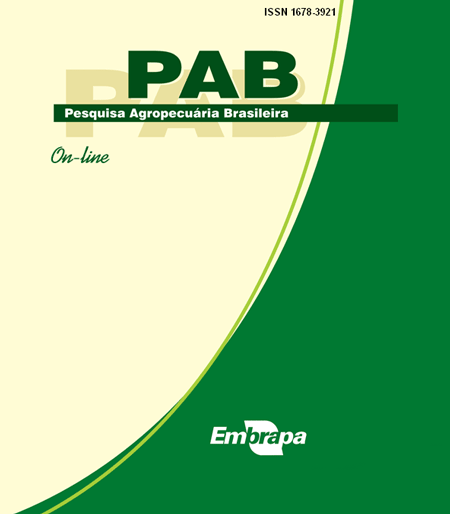Ver ítem
- xmlui.general.dspace_homeCentros e Institutos de InvestigaciónCIAP. Centro de Investigaciones AgropecuariasInstituto de Patología VegetalArtículos científicosxmlui.ArtifactBrowser.ItemViewer.trail
- Inicio
- Centros e Institutos de Investigación
- CIAP. Centro de Investigaciones Agropecuarias
- Instituto de Patología Vegetal
- Artículos científicos
- Ver ítem
Incidence of Garlic common latent virus in Argentina, and phylogenetic and recombination analyses of isolates = Incidência de Garlic common latent virus na Argentina, e análise filogenética e de recombinação de isolados
Resumen
The objective of this work was to estimate the incidence and prevalence of Garlic common latent virus
(GarCLV) in the main production regions of garlic (Allium sativum) in Argentina, and to perform phylogenetic
and recombination analyses in isolates from these regions. Leaf samples (3,050) were taken from four garlic
commercial types, in 13 departments of the four main garlic‑producing provinces of Argentina, in a 1,175‑ha
sampling area. Virus
[ver mas...]
The objective of this work was to estimate the incidence and prevalence of Garlic common latent virus
(GarCLV) in the main production regions of garlic (Allium sativum) in Argentina, and to perform phylogenetic
and recombination analyses in isolates from these regions. Leaf samples (3,050) were taken from four garlic
commercial types, in 13 departments of the four main garlic‑producing provinces of Argentina, in a 1,175‑ha
sampling area. Virus infection was evaluated with DAS‑Elisa test using specific antiserum, and the phylogenetic
and recombination analyses were done with capsid protein (CP) nucleotide sequence of seven GarCLV isolates
from the provinces. The incidence of GarCLV in the evaluated provinces varied between 6.7 and 22% of the
samples, whereas the prevalence varied between 52.6 and 70%. In the analysis of garlic commercial types,
Morado showed the highest incidence of the virus, in the province of San Juan, whereas Rosado Paraguayo had
the lowest incidence, in the province of Cordoba. Nucleotide identity in the CP sequences ranged between 80.3
and 97.6%. The phylogenetic analysis shows the presence of two main groups of GarCLV and of a possible third
group that would include only a German isolate. The recombination analysis between isolates from different
parts of the world evidences the presence of recombinant isolates from Poland and Australia.
[Cerrar]
O objetivo deste trabalho foi estimar a incidência e a prevalência de Garlic common latent virus
(GarCLV) nas principais regiões produtoras de alho (Allium sativum) da Argentina, e realizar análises
filogenética e de recombinação de isolados dessas regiões. Amostras foliares (3.050) foram coletadas de
quatro tipos comerciais de alho, em 13 departamentos, nas quatro principais províncias produtoras de alho
na Argentina, em uma área amostrada de 1.175
[ver mas...]
O objetivo deste trabalho foi estimar a incidência e a prevalência de Garlic common latent virus
(GarCLV) nas principais regiões produtoras de alho (Allium sativum) da Argentina, e realizar análises
filogenética e de recombinação de isolados dessas regiões. Amostras foliares (3.050) foram coletadas de
quatro tipos comerciais de alho, em 13 departamentos, nas quatro principais províncias produtoras de alho
na Argentina, em uma área amostrada de 1.175 ha. A infecção viral foi avaliada pelo teste DAS‑Elisa com
antissoro específico, e as análises filogenética e de recombinação foram feitas com sequências de nucleotídeos
da proteína capsidial (CP) de sete isolados das províncias. A incidência de GarCLV nas províncias avaliadas
variou de 6,7 a 22% das amostras, enquanto a prevalência variou de 52,6 a 70%. Na avaliação dos tipos
comerciais de alho, Morado apresentou as maiores incidências do vírus, na Província de San Juan, enquanto
Rosado Paraguayo apresentou a menor incidência, na Província de Córdoba. A identidade de nucleotídeos
nas sequências de CP variou entre 80,3 e 97,6%. A análise filogenética mostra a presença de dois grupos
principais de GarCLV e de um possível terceiro grupo formado por apenas um isolado da Alemanha. A análise
de recombinação entre isolados de diferentes partes do mundo evidencia a presença de isolados recombinantes
da Polônia e da Austrália.
[Cerrar]

Fecha
2015-05
Editorial
Embrapa
ISSN
1678-3921
Formato
pdf
Tipo de documento
artículo
Palabras Claves
Derechos de acceso
Abierto
 Excepto donde se diga explicitamente, este item se publica bajo la siguiente descripción: Creative Commons Attribution-NonCommercial-ShareAlike 2.5 Unported (CC BY-NC-SA 2.5)
Excepto donde se diga explicitamente, este item se publica bajo la siguiente descripción: Creative Commons Attribution-NonCommercial-ShareAlike 2.5 Unported (CC BY-NC-SA 2.5)


